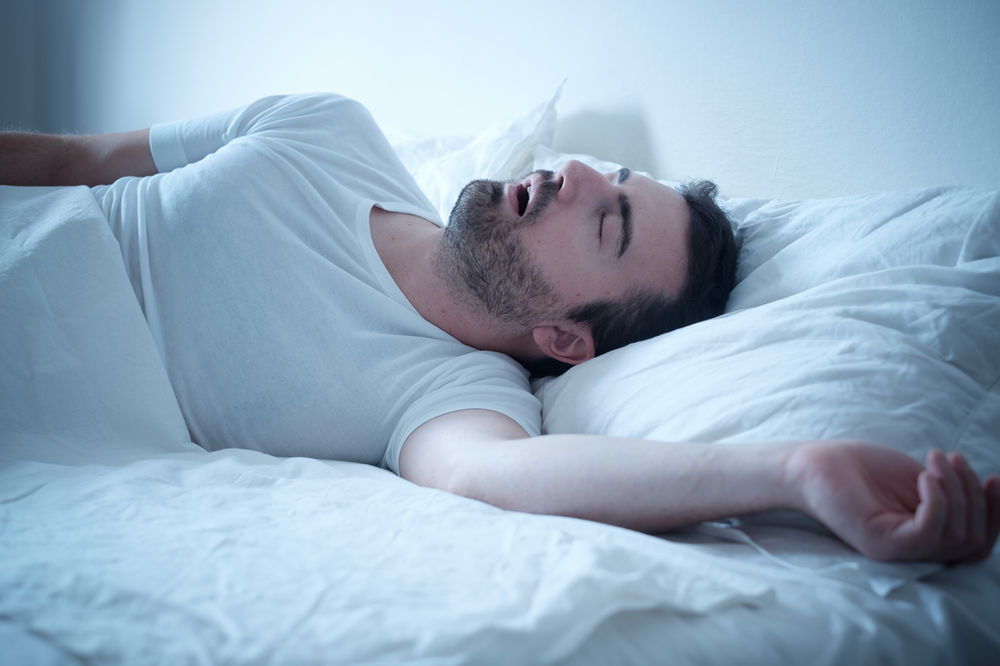The main difference between sleep apnea and snoring is that sleep apnea is a medical condition where breathing repeatedly stops and starts during sleep, often increasing the risk of developing serious health implications like cardiovascular problems and impaired cognitive function.
In contrast, snoring is usually a less severe condition, characterised by noisy breathing during sleep without your breathing stopping. While snoring can be a symptom of sleep apnea, it doesn’t necessarily indicate the presence of this more serious disorder.
Sleep apnea is a potentially serious sleep disorder that warrants professional attention.
What causes snoring and sleep apnea?
Snoring occurs when the flow of air through the mouth and nose is partially blocked during sleep. This blockage leads to the vibration of the relaxed throat tissues, producing the characteristic sound of snoring. Several factors contribute to snoring, including:
- Anatomy: The physical structure of the mouth and throat, including the size of the uvula,tonsils and tongue, can influence snoring.
- Sleep Position: Sleeping on your back can cause the tongue and soft palate to collapse to the back of the throat, narrowing the airway and promoting snoring.
- Nasal Congestion: Obstructed nasal passages due to allergies, sinus infections, or anatomical issues can lead to increased air resistance, contributing to snoring.
- Age and Muscle Tone: As people age, muscle tone in the throat and tongue will decrease, making them more prone to snoring.
- Weight: Excess body weight, especially around the neck, can put pressure on the airway, increasing the likelihood of snoring.
The interruptions in breathing that characterise sleep apnea can result from a complete or partial blockage of the airway. There are different kinds of sleep apnea that have their own causes, including:
Obstructive Sleep Apnea (OSA):
- Similar to snoring, the physical structure of the throat and mouth can contribute to airway obstruction.
- Excess weight, especially around the neck, can increase the likelihood of airway blockage.
Central Sleep Apnea (CSA):
- Dysfunction in the brain’s respiratory control centre, which is part of the central nervous system, can lead to CSA, where the brain fails to send proper signals to the muscles that control breathing.
Complex Sleep Apnea Syndrome (Mixed or Treatment-Emergent):
- Some individuals experience a combination of both obstructive and central sleep apnea, known as complex sleep apnea syndrome.
Do snoring and sleep apnea share risk factors?
Yes, snoring and sleep apnea share several risk factors, although the severity and impact of these factors vary between the two. Common risk factors that contribute to both snoring and sleep apnea include:
- Excess bodyweight
- The physical structure of the throat and mouth (e.g. enlarged tonsils or a long uvula)
- Older age
- Genetics (e.g. family history)
- Alcohol and sedative use
- Sleep position
Can snoring lead to sleep apnea?
While snoring itself is a common occurrence and often harmless, persistent and loud snoring can sometimes be an indicator of an underlying issue, including sleep apnea. Over time, habitual snoring can potentially progress to sleep apnea as well.
Ultimately, it’s important to recognise that not everyone who snores will develop sleep apnea, but chronic and disruptive snoring may warrant professional evaluation, particularly if you observe additional symptoms such as gasping or choking during sleep.
How are snoring and sleep apnea treated?
Treatments for snoring include:
- Losing excess weight, especially around the neck, can reduce pressure on the airway and alleviate snoring.
- Sleeping on the side rather than the back, which may help prevent the collapse of throat tissues, reducing snoring.
- Pillows designed to encourage sleeping on the side can also be effective in reducing snoring.
- Limiting the consumption of alcohol and sedative medications, especially before bedtime, as this can prevent muscle relaxation in the throat that contributes to snoring.
- Nasal Strips applied to the nose to improve airflow and reduce snoring.
- Devices such as oral appliances or chin straps, which help keep the airway open during sleep.
Treatments for sleep apnea include:
- Continuous Positive Airway Pressure (CPAP), which delivers a continuous stream of air through a mask, preventing the airway from collapsing during sleep.
- Bi-level Positive Airway Pressure (BiPAP), which is similar to CPAP, but also adjusts the air pressure, providing higher pressure during inhalation and lower pressure during exhalation.
- Dental devices, such as mandibular advancement devices, that can help reposition the jaw and tongue to keep the airway open.
- Lifestyle Modifications, such as weight loss and positional therapy.
- Depending on the type of sleep apnea as well as the age you are, some surgical procedures may reduce the severity of sleep apnea.
Where can I go for effective diagnosis and treatment for sleep apnea?
At Manse Medical, we offer high-quality diagnosis and care for sleep disorders, including sleep apnea. Book your appointment online, select your preferred clinic, and choose from our list of specialised experts to get the medical care you need.



